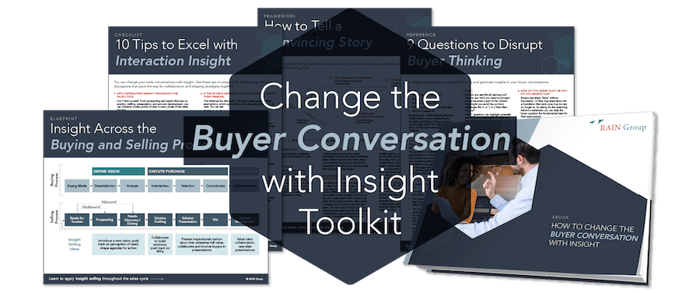The best sellers do more than just close sales. They reshape buyer thinking and drive change through the value they provide.
We call this insight selling, and it hinges on the concept of cognitive reframing.
What is Cognitive Reframing?
Cognitive reframing refers to the creation of alternative ways of viewing ideas, events, situations, strategies, or possibilities for action—or really anything. In other words: driving change with ideas that matter. The reframing is how to get the change started.
Here’s why the concept of cognitive reframing is so important: if buyers believe they know everything about their current situation and how to move forward, they’re confident. They’re steering the ship and simply looking for solutions to get to their destination. They’re in their comfort zones.
The challenge for sellers here is that buyers’ minds are closed. They’re on autopilot heading to their destination. They’re resistant to change.
Your job is to guide them out of their comfort zone and into a place of learning. There are three stages of this process.
3 Stages of Driving Change with Buyers
Disrupt Buyer Thinking
At first, buyers are resistant to change. You need to balance inquiry (asking questions) with advocacy (sharing ideas) to get them to see the gaps between how they’re thinking about something and how they should be thinking about it.
Reframe the Issue
At this point, you can reframe the conversation by shaping the point of view through which they view the issue at hand. Keep in mind that this process is collaborative. The more you can engage your buyer and work with them to solve their problems, the more impactful the reframing will be.
Direct for Action
Finally, you can direct your buyer to new and better possibilities. But beware. The danger here is pushing buyers so far that they get overwhelmed and shut down. This is what we call the paralysis zone. It’s not very helpful to buyers (or anyone) to be here.
Remember that you’re there to guide the buyer and provide value, not dictate how they should act.
Insight Planning: What Buyers Are Thinking
With all of this in mind, you may be wondering where to start. You can’t read your buyer’s mind, but you can ask yourself several questions to uncover what they might be thinking and how you can challenge their beliefs.
In this video, we share 3 questions to help you lead rigorous and buyer-focused conversations.

1. What are the buyer points of view that need to change?
To uncover these, ask yourself,
- What should they be dissatisfied with?
- What don’t they know about how they should solve their problems?
- What better future could they have that they don’t perceive now?
- What’s changed recently that necessitates a new point of view?
The magic in this exercise is making sure you’ve already created an excellent list of buyer points of view that commonly need to change. That way, you can easily scan the list for points of view applicable to this specific buyer’s situation. For example,
- Do they ask you for older ways of doing things that have been replaced recently with innovations they aren’t aware of?
- When they implement your offerings, do buyers make common mistakes? Do they not give enough time, not think of it as a change management initiative, or buy too little or too low quality and suffer later? Or, perhaps, they overdo it in one area when they can pare back and re-deploy resources elsewhere?
- Do they think they don’t need to do something, when, if they don’t, they’ll lose to their competitors in the coming years?
- Are they not anticipating strategic shifts coming in the next several years that you know are coming and which might not be on their radar yet?
- Do they assume something’s cost is at a certain level, when you know the cost will be more or could actually cost less if they change their approach?
- Do they think something is risky when it’s not? Do they think something is safe and easy to do when it’s actually risky?
Understanding the answers to these questions starts with a strong knowledge of both the buyer’s industry and yours. Make it a habit to become a well-informed industry insider before talking with a buyer.
You need to know, for your industry and the buyers’ industry:
- The industry itself, including the players, associations, and companies
- The news of the day, and the competitive landscape: who’s rising and falling, who has bought whom, and who’s good at what and who’s not
In addition, learn about the buyer’s business. You can’t know more about their business than them, but you can learn enough to be seen as a knowledgeable insider when it comes to them and their business. Effort here is the key, and buyers notice.
When you demonstrate you understand their business, their pressures, their culture, their strategies and agendas, how they make money, their competitors, and so on, they’re much more likely to accept your advice.
2. What are the points of view you bring to the table that buyers should consider?
To uncover these, ask yourself,
- What new perspectives do I bring to the table about how they could solve their afflictions or problems?
- How could they achieve aspirations that they might not even perceive are possible now?
- What innovations have never been tried that they should consider?
- What non-intuitive insight can I bring to the table to make them say, “Aha! I’ve never thought of that!”
Good sellers are influencers. You can be a change agent and influencer to an extent with powerful questions and inquiry, but you’ll always be limited if you don’t have something specific to advocate for.
As an example, one of our clients in the leadership training industry frequently has buyers ask for multiple-day retreats to help their managers become more innovative. The retreats have value, but to help drive innovation at the company, the managers often need coaching, experiences, and team innovation assessments that retreats don't offer.
Often, buyers ask for something they think will help them achieve a specific result, but you know getting that result is best done another way (cheaper, faster, more effective, etc.).
Ask yourself: what do I bring to table to change my buyers’ thinking or approach?
If you aren’t comfortable putting a stake in the ground behind an issue or concept, you’ll be challenged when trying to implement insight selling. You need to be able to communicate your point of view and impact persuasively.
Can you tell a Convincing Story? Can you shake up the status quo with provocative questions? Can you see how what you’re advocating for will affect the rest of the buyer’s business?
Sellers who aren’t prepared to present persuasively and influence have a difficult time getting results.
Download our How to Make Persuasive Sales Presentations Toolkit. >>
3. Why should buyers change their thinking?
To uncover this answer, ask yourself,
- What is the cost of failing to shift the buyers' point of view?
- Why is it vital to embrace a new idea or solution now?
- What is the value of the new point of view?
For anything you advocate, you must be able to answer the question why. There’s the logical impact story (often ROI), as well as an emotional impact.
The higher up you sell, the more important it is to be able to justify the business impact in financial terms. If you don’t know how the money works—if you don’t know how to make calculations about how your products/solutions will affect their top and bottom lines—you’ll always have trouble justifying and communicating the power of your point of view.
And if you can’t communicate its value and defend its validity, don’t expect buyers to buy it.
That justification could mean:
- Faster
- Less expense
- More likely to succeed
- New and better
- Drive more revenue
- Drive more market share
- Reduce scrap and rework
Be prepared to share that justification with your buyer. When you can share compelling results you’ve achieved elsewhere, you might just find the buyer changing their point of view.
As a result, they’ll see you as a critical relationship for them because of the value you bring to the table.
 Disrupt, reframe, and direct the discussion to get buyers thinking differently with our toolkit, How to Change the Buyer Conversation with Insight. Download now. >>
Disrupt, reframe, and direct the discussion to get buyers thinking differently with our toolkit, How to Change the Buyer Conversation with Insight. Download now. >>






